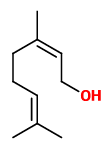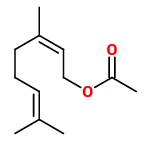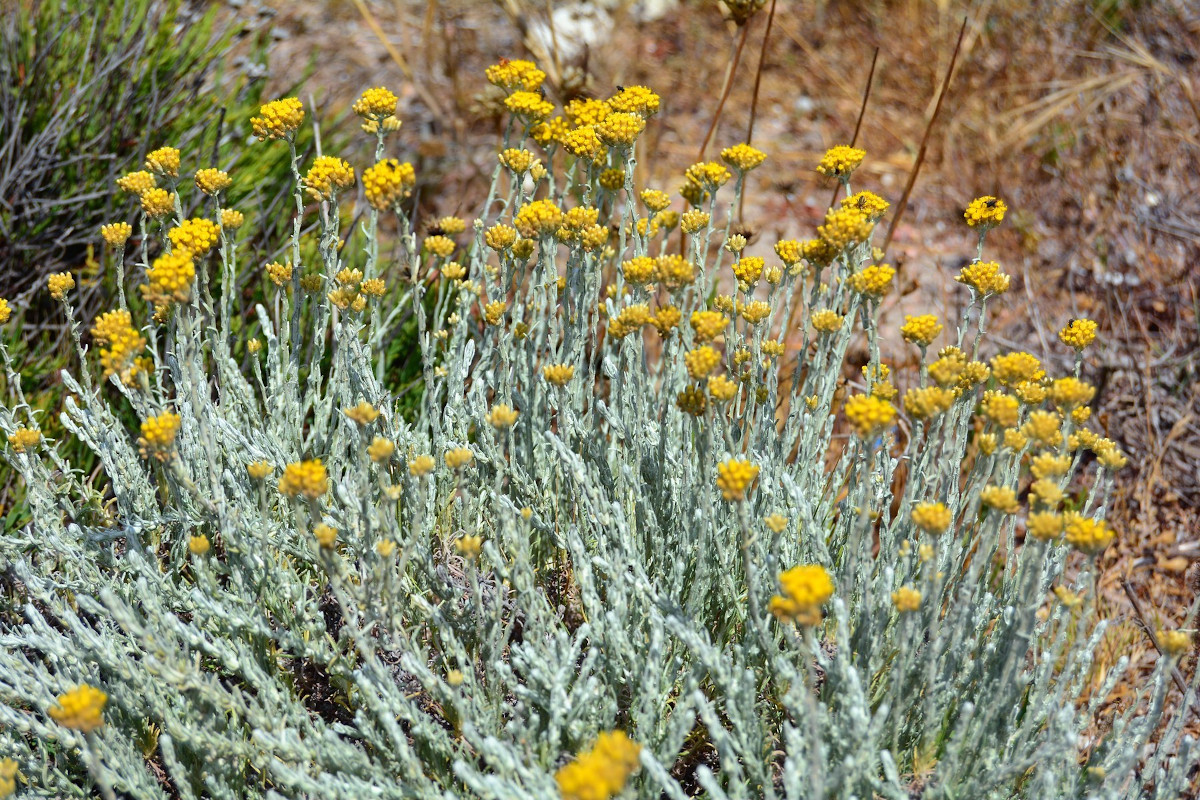Benutzer-Werkzeuge
Helichrysum italicum (Roth) G. Don - syn. Gnaphalium italicum Roth - Asteraceae
curryplant, everlasting, immortelle, Italienische Strohblume, Currystrauch, Italienische Immortelle, Currykraut
Dwarf aromatic shrub, up to 20-60 cm high, growing on dry cliffs and sandy soil along the Mediterranean coast. Flowers yellow, young leaves with grayish-white tomentose hairs.
Helichrysum serotinum Boiss. = syn. Helichrysum italicum subsp. serotinum
https://npgsweb.ars-grin.gov/gringlobal/taxonomydetail.aspx?27969
„This plant is sometimes used as a spice. Although called „curry plant“ and smelling like curry powder, it has nothing whatsoever to do with this mixture of spices, nor with the curry tree (Murraya koenigii), and is not used as masala for curry dishes either.“ http://en.wikipedia.org/wiki/Helichrysum_italicum
„The strong scent of flowers reminiscent of curry, it is particularly intense during hot weather.“ http://de.wikipedia.org/wiki/Helichrysum_italicum
„…Corsican oils were found to contain neryl acetate as predominant compound, with amounts from 15.8% (from plants in stage of early shoots) to 42.5% (in full flowering period). In a second part, we sampled Helichrysum italicum subsp. italicum from three locations over the growth cycle of the plant. Significant variations were observed in the concentration of the main constituents, pointing out a chemical composition of oils produced from plants in early shoots (higher amounts of ketones and β‐diketones [like 3,5-dimethylheptan-2,4-dione and 4,6-dimethyloctan-3,5-dione]) different from that obtained from samples harvested in the stages of flowering (higher contents of neryl acetate).“
[Bianchini, Ange, et al. „Composition of Helichrysum italicum (Roth) G. Don fil. subsp. italicum essential oils from Corsica (France).“ Flavour and fragrance journal 16.1 (2001): 30-34]
 4,6-dimethyloctan-3,5-dione (curry plant like) |  nerol (lemon floral) |  neryl acetate (sweet floral rose) |
Tuscan Helichrysum italicum subsp.italicum oils exhibited high contents of sesquiterpene hydrocarbons (23-38%) with significant amounts of β-selinene (7-12%), β-caryophyllene (5-11%) and α-selinene (5-8%). The major compounds were α-pinene (53.5% max) or neryl acetate (22.0% max).
Main components of Corsican oils were always neryl acetate (33.7-38.9%), neryl propionate (3.4-5.9%) and β-diketones (total 4.8-9.4%) like 4,6-dimethyloctan-3,5-dione and 4,6,9-trimethyldec-8-en-3,5-dione.
Hydrodistilled oils obtained from Sardinian and Corsican H.italicum subsp.microphyllum showed strong similarities with neryl acetate (33.9-52.5%), nerol (3.9-8.1%), and total β-diketones (0.8-5.3%).
[A comparative study of volatile constituents of two Helichrysum italicum (Roth) Guss. Don Fil subspecies growing in Corsica (France), Tuscany and Sardinia (Italy)., Bianchini, A., Tomi, P., Bernardini, A.F., Morelli, I., Flamini, G., Cioni, P.L., Marchetti, M., Flavour and fragrance journal, 18(6), 2003, 487-491]
Analysis (random amplified polymorphic DNA -RAPD- technique and chemical analysis) of the Sardinian dwarf curry plant, Helichrysum italicum G. Don ssp.microphyllum, showed two distinct chemotypes. The essential oil (0.11-0.18%) of type A is rich in nerol (9-20%), its esters neryl acetate (16-26%) and neryl propionate (9-14%), linalool (12-22%) and limonene (1-7%).
„These compounds have nice perfume and for this reason are widely used in cosmetics. The concentration of these compounds is higher during the flowering stage and quite higher in the flowers than in the stems. Therefore, the distillation of flowers and stems together does not affect the commercial quality. Type A oils could be used in cosmetics and aromatherapy, whereas type B oils may possibly be employed as biopesticides… It is well-known that Helichrysum has a moderate anti-microbial activity, which is generally attributed to nerol esters. These compounds are completely absent in the essential oil of Helichrysum type B, which unexpectedly showed a good antifungal action against Pythium ultimum and Sclerotium rolfsii and a moderate action against Phytophthora capsici and Septoria tritici.“
[Chemical composition, plant genetic differences, and antifungal activity of the essential oil of Helichrysum italicum G. Don ssp. microphyllum (Willd) Nym., Angioni, A., Barra, A., Arlorio, M., Coisson, J.D., Russo, M. T., Pirisi, F. M., Cabras, P., Journal of agricultural and food chemistry, 51(4), 2003, 1030-1034]
„The chemical composition of the everlasting essential oils from Greece and Croatia are quite different. Oil from Croatia is similar to the oil of Italian origin and its chemical composition varies in relation to the geographic origin and vegetation cycle…The yield of the essential oil obtained by hydrodistillation was 0.21% (w/w) and forty four compounds were identified. The main compounds were: α-pinene (12.8%), 2-methylcyclohexyl pentanoate (11.1 %), neryl acetate (10.4%), 1,7-di-epi-α-cedrene (6.8%), thymol (5.4%), eremophilene (4.3%), limonene (4.0%), 2,3,4,7,8,8a-hexahydro-1H-3a,7-methanoazulene (3.1%), α-bergamotene (2.6%) and ar-curcumene (2.3%). Everlasting essential oil exhibited a very complex composition… Seven esters were identified, representing 29.0% of the total oil. 2-Methylcyclohexyl pentanoate and 2-methylcyclohexyl octanoate were tentatively identified. Furthermore, thymol (5.4%), eleven free alcohols (mono- and sesquiterpene alcohols) and six acids - (E)-2-methyl-2-butenoic, octanoic, decanoic, undecanoic, dodecanoic and tetradecanoic acid - were found, representing 3.7% of the total oil.“
[Contribution to the Analysis of the Essential Oil of Helichrysum
italicum (Roth) G. Don. – Determination of Ester Bonded Acids
and Phenols. Josip Mastelić, Olivera Politeo, Igor Jerković, Molecules 2008, 13, 795-803]
The main compounds of 21 essential oil samples isolated from Helichrysum italicum ssp.italicum collected in seven locations of Elba Island were α-pinene (1.0-32.9%), limonene (0.4-12.9 %), 1,8-cineol (tr-18.2%), linalool (1.1-6.7%), nerol oxide (tr-2.8%), nerol (2.8-12.8%), neryl acetate (5.6-45.9%), neryl propionate (1.9-7.7%), ɣ-curcumene (1.0-7.2%), ar-curcumene (0.5-6.7%), and rosifoliol (eudesm-5-en-8-ol, 1.8-17.2%). Neryl isovalerate (sour sweaty floral rose) was found at 0.1-1.3%.
„The results obtained showed a difference in the composition of the essential oils of H. italicum from Elba Island, mainly due to the environment where the plant grows, and, in particular, to the soil type. These hypotheses were further confirmed by the comparison of these oils with essential oils obtained from H. italicum collected on other islands of the Tuscan archipelago.“
[Essential‐Oil Composition of Helichrysum italicum (Roth) G. Don ssp. italicum from Elba Island (Tuscany, Italy)., Leonardi, M., Ambryszewska, K.E., Melai, B., Flamini, G., Cioni, P.L., Parri, F., Pistelli, L., Chemistry & biodiversity, 10(3), 2013, 343-355]
The olfactometry profile of Helichrysum italicum essential oil from Balkans showed green notes (nerol oxide, 2,4-decadienal, ɣ-curcumene, three unknown compounds), fruity notes (damascenone, italidione I, italidione II/α-curcumene), terpenic notes (1,8-cineole, α-terpineol), nutty notes (pyrazine, terpinen-4-ol), floral notes (linalool), the animalic p-cresyl acetate, and the spicy isobutyl angelate.
[Laure Saint-Lary, Francis Hadji Minaglou, Christian Escriva, Anne-Sophie Beyls, Frédéric Badie: „Helichrysum italicum D.C. Essential Oil from Balkans“ Perfumer and Flavorist 47 (2018): 52-66]
Neryl acetate as the main component (30.4%) of a steam distilled essential oil of Helichrysum italicum subsp. italicum from Corsica was not a key odorant (only 2 of 10 panelists detected a weak odor zone by GC-O). The most odor-active constituents perceived by all of the panelists and showing the highest mean Flavor Dilution factor were 4,6-dimethyloctan-3,5-dione (0.7%, curry plant-like), 1,8-cineole (1.0%, menthol floral), and nerol (3.7%, lemon floral). Other odor-active constituents were α-pinene (2.1%, lemon floral), p-cresol (trace, sweat spicy curry), linalool (2.4%, orange blossom, citrus), eugenol (0.1%, spicy fruity), and β-damascenone (only detected by GC-O, fruity rose) and another eleven compounds which could not be identified.
[Andreani, Stéphane, et al. „Key odorants of industrially-produced Helichrysum italicum subsp. italicum essential oil.“ Industrial Crops and Products 132 (2019): 275-282]

Helichrysum italicum subsp. microphyllum (Asteraceae)
Author: Giancarlo Dessì (2007), Professional Institute of Agriculture and Environment „Cettolini“ of Cagliari
CC BY-SA 3.0, Wikimedia Commons
